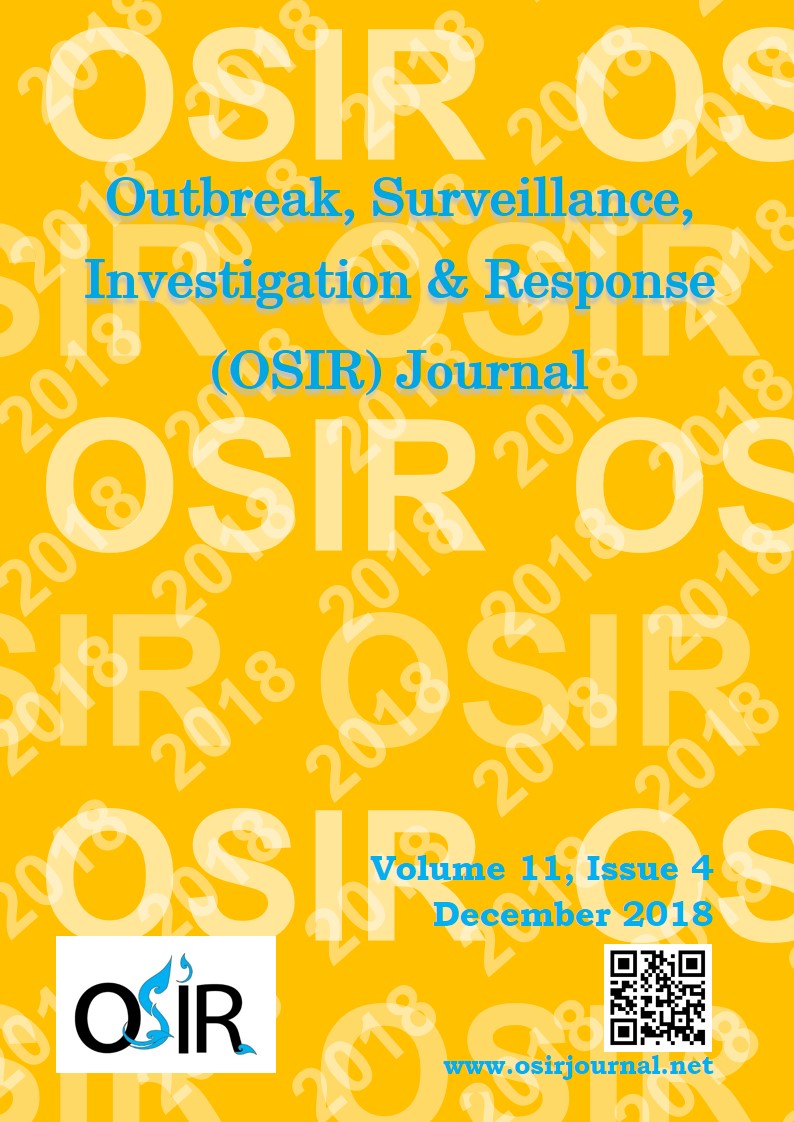Evaluation of Early Aberration Reporting System for Dengue Outbreak Detection in Thailand
DOI:
https://doi.org/10.59096/osir.v11i4.263047Keywords:
dengue, public health informatics, early disease detection, surveillance systems, disease notification, Thailand, EARS, 5-year medianAbstract
Thailand is one of the highest-burden countries for dengue infections in the South-East Asia Region of the World Health Organization. The 5-year median is normally used for outbreak detection; however, studies assessing the performance of this indicator against other detection methods are lacking. We, therefore, conducted a descriptive ecological study from a dataset comprised of patient visits to public hospitals for dengue treatment that were reported to the Ministry of Public Health. The aim was to evaluate the performance of an early aberration reporting system (EARS) in detecting dengue outbreaks, compared to using the 5-year median method. During 2003-2015, there were 1,014,201 patient visits and seven reported dengue outbreaks, with the largest occurring in 2013, and six seasonal peaks. The EARS was able to detect all seven dengue outbreaks and six seasonal peaks, including one outbreak that occurred in 2014 which was undetected by the 5-year median. However, EARS cannot provide information on trends, outbreak severity and issues noise signals. Our recommendation was to combine the EARS with the 5-year median method to reduce the number of false positive signals, or use the 5-year median method as a confirmatory tool.
References
Gubler DJ. The economic burden of dengue. Am J Trop Med Hyg. 2012;86(5):743-4.
World Health Organization and the Special Programme for Research and Training in Tropical Diseases. Dengue guidelines for diagnosis, treatment, prevention and control: new edition. Geneva: World Health Organization; 2009.
Thailand. Bureau of Epidemiology. Department of Disease Control. Ministry of Public Health. Dengue hemorrhagic fever. 2016 [cited 2018 Aug 20]. <http://www.boe.moph.go.th/boedb/surdata/506wk/y58/d262766_5258.pdf>
Clark DV, Mammen MP, Nisalak A, Puthimethee V, Endy TP. Economic impact of dengue fever/dengue hemorrhagic fever in Thailand at the family and population levels. Am J Trop Med Hyg. 2005;72(6):786-91.
Runge-Ranzinger S, McCall PJ, Kroeger A, Horstick O. Dengue disease surveillance: an updated systematic literature review. Trop Med Int Health. 2014;19(9):1116-60.
Chen H, Zeng D, Yan P. Infectious disease informatics: syndromic surveillance for public health and bio-defense. New York: Springer Science; 2010.
Brady OJ, Smith DL, Scott TW, Hay SI. Dengue disease outbreak definitions are implicitly variable. Epidemics. 2015;11:92-102.
Fefferman N, Naumova E. Innovation in observation: a vision for early outbreak detection. Emerg Health Threats J. 2010;3:e6.
Zhu Y. Initial evaluation of the early aberration reporting system --- Florida. MMWR. 2005;54(Suppl):123-30.
Fricker RD, Hegler BL, Dunfee DA. Comparing syndromic surveillance detection methods: EARS' versus a CUSUM-based methodology. Stat Med. 2008;27(17):3407-29.
R Core Team. R: A language and environment for statistical computing. R Foundation for Statistical Computing. 2014. [cited 2018 Nov 22]. <http://www.R-project.org/>
Yang P, Duan W, Lv M, Shi W, Peng X, Wang X, et al. Review of an influenza surveillance system, Beijing, People's Republic of China. Emerg Infect Dis. 2009;15(10):1603-8.
Sloane PD, MacFarquhar JK, Sickbert-Bennett E, Mitchell CM, Akers R, Weber DJ, et al. Syndromic surveillance for emerging infections in office practice using billing data. Ann Fam Med. 2006;4(4):351-8.
Makaroon J, Pittayawonganon C, Gross DK, McMorrow M. An evaluation of influenza-like illness (ILI) epidemic thresholds in two provinces of Thailand, 2007-2010. OSIR. 2013 Mar; 6(1):13-18.
Downloads
Published
How to Cite
Issue
Section
License
Copyright (c) 2023 Outbreak, Surveillance, Investigation & Response (OSIR) Journal

This work is licensed under a Creative Commons Attribution-NonCommercial-NoDerivatives 4.0 International License.









